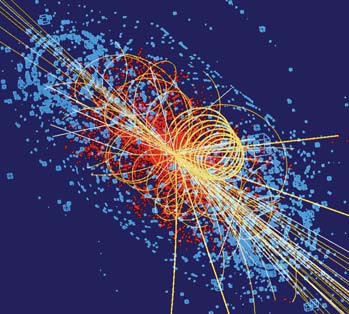Quantum Field Theory
 Quantum field theory is the language in which all of modern physics is formulated. It represents the marriage of quantum mechanics with special relativity and provides the mathematical framework in which to describe the creation and destruction of hoards of particles as they pop in and out of their ethereal existence and interact. Whether you want to understand the collisions of protons at the LHC, how electrons co-operate inside solids, or how black holes evaporate, you need to work with quantum field theory. Moreover, it has also proven to be a remarkably subtle and rich subject for mathematicians, providing insights into many new areas of mathematics.
Quantum field theory is the language in which all of modern physics is formulated. It represents the marriage of quantum mechanics with special relativity and provides the mathematical framework in which to describe the creation and destruction of hoards of particles as they pop in and out of their ethereal existence and interact. Whether you want to understand the collisions of protons at the LHC, how electrons co-operate inside solids, or how black holes evaporate, you need to work with quantum field theory. Moreover, it has also proven to be a remarkably subtle and rich subject for mathematicians, providing insights into many new areas of mathematics.
When the interactions between particles are weak, quantum field theory can be well understood using perturbative techniques of Feynman diagrams. However, when the interactions between particles become strong, these methods no longer work and one must develop new mathematical tools and techniques. Such tools are necessary to understand phenomena such as the confinement of quarks inside protons and neutrons, or the fractionalization of electrons in the quantum Hall effect.
Members of the HEP group are actively engaged in understanding various aspects of strongly coupled field theories through lattice field theory, supersymmetry, integrability, gauge/gravity duality and other techniques
Faculty working in these areas include :
- Dr Alejandra Castro
- Prof Nick Dorey
- Dr Jonathan Evans
- Prof Sean Hartnoll
- Prof Ron Horgan (emeritus)
- Prof Nick Manton (emeritus)
- Prof Hugh Osborn (emeritus)
- Prof Harvey Reall
- Prof David Skinner
- Prof Jorge Santos
- Prof Christopher Thomas
- Prof David Tong
- Dr Aron Wall
- Prof Matthew Wingate
Quantum Gravity
 Quantum gravity remains one of the great open problems in theoretical physics. The advent of the AdS/CFT correspondence provided a framework in which one can fruitfully address difficult questions about quantum gravity in a precise and quantitative manner, and this continues to play a major role in our research. However, there is an increasing appreciation of the need to take questions of gravity into more realistic settings. The study of various quantum properties of black holes (for example information loss, cosmic censorship and entropy) is of particular interest. There is a close collaboration between members of the High Energy Physics Group and the Relativity Group.
Quantum gravity remains one of the great open problems in theoretical physics. The advent of the AdS/CFT correspondence provided a framework in which one can fruitfully address difficult questions about quantum gravity in a precise and quantitative manner, and this continues to play a major role in our research. However, there is an increasing appreciation of the need to take questions of gravity into more realistic settings. The study of various quantum properties of black holes (for example information loss, cosmic censorship and entropy) is of particular interest. There is a close collaboration between members of the High Energy Physics Group and the Relativity Group.
String theory is a theory of quantum gravity and is an ambitious project. It purports to be an all-encompassing theory of the universe, unifying the forces of nature, including gravity, in a single quantum mechanical framework. String theory also offers new mathematical tools to understand aspects of strongly coupled field theories and gives new insights into questions in general relativity. Members of DAMTP have played a leading role in the development of superstring theory and M-theory. Current research is focussed in a number of directions, including developing a better understanding of the underlying structure of string theory, extracting predictions for particle physics and cosmological scenarios.
HEP group faculty interested in these areas :
- Dr Alejandra Castro
- Prof Nick Dorey
- Prof Maciej Dunajski
- Prof Michael Green (emeritus)
- Prof Sean Hartnoll
- Dr Enrico Pajer
- Prof Malcolm Perry (emeritus)
- Prof Fernando Quevedo (emeritus)
- Prof Harvey Reall
- Dr Ron Reid-Edwards
- Prof Jorge Santos
- Prof David Skinner
- Prof David Tong
- Prof Paul Townsend (emeritus)
- Dr Aron Wall
Particle Phenomenology

The Large Hadron Collider (LHC) is currently the world's high energy frontier. There is close collaboration with theorists in the High Energy Physics Group at the Cavendish Laboratory and contact with the experimentalists there. To facilitate this, the Cambridge Pheno Working Group meets once per week at the Cavendish laboratory to push projects forward. The emphasis is on what can be done with the experiments.
Knowledge of the non-perturbative structure of the proton is essential to interpret LHC experiments and this comes from a combination of Standard Model theory and fits to data. Calculations at higher orders in perturbation theory help test the Standard Model (and a precision understanding of Quantum Choromodynamics).
The discovery of a particle that looks and behaves very much like a Higgs boson as an inferred test of the Bose-Englert-Higgs mechanism of mass generation, is a triumph for 20th century theoretical physics. However, many questions remain unanswered, such as: why is the Higgs boson stable with respect to quantum fluctuations? Why do the fermions have a peculiar pattern of masses and mixings? What is dark matter? What caused the baryon asymmetry of the universe? An in-depth and precise understanding of the structure of the proton and of QCD is essential for extracting information on the collisions.
Speculative effective field theory models such as supersymmetric models or large extra dimensions solve some of these problems and their phenomenology and their LHC signals are the subject of active research. Intriguing beyond the Standard Model rates are seen in meson decays and these are a focus of particular interest, with explanations involving new fields in the TeV range that can be directly searched for.
String theory model building connects the high energy scales of string theory to weak scale phenomenology. The ambitious goal is to construct a predictive and testable string model. String theory models can have an impact on the expected gauge groups and particles in the effective quantum field theory.
Faculty members of the HEP group interested in these areas include :
- Prof Ben Allanach
- Prof Anne Davis (emeritus)
- Prof Ben Gripaios (Cavendish)
- Prof Alex Mitov (Cavendish)
- Prof Fernando Quevedo (emeritus)
- Prof Maria Ubiali
- Prof Bryan Webber (Cavendish, emeritus)
Lattice Field Theory
 Lattice field theory combines techniques from quantum field theory and statistical field theory to study systems with strongly interacting particles. "The lattice" is both mathematically beautiful and computationally practical: quantum field theories formulated in a discrete spacetime are finite and mathematically well-defined; furthermore the theories are amenable to numerical solution without recourse to having a small expansion parameter.
Lattice field theory combines techniques from quantum field theory and statistical field theory to study systems with strongly interacting particles. "The lattice" is both mathematically beautiful and computationally practical: quantum field theories formulated in a discrete spacetime are finite and mathematically well-defined; furthermore the theories are amenable to numerical solution without recourse to having a small expansion parameter.
Members of our group are using "the lattice" primarily to study the physics of quarks through a combination of effective field theory and numerical calculations. For example, the details of how quarks change their flavour provide clues to the physics we expect to find beyond our current Standard Model of particle physics. Precise lattice QCD calculations connect experimental measurements of hadron flavour interactions with the structure of quark flavour interactions in fundamental Lagrangians. There is a nascent interest in developing algorithms for use on quantum computers for performing lattice calculations.
We also maintain active interest in applying similar theoretical methods to the flow and diffusion in random media, to the thermodynamics of ultracold atoms, as well as other areas for which ideas of field theory and statistical physics are relevant.
Members of the group participate in the UKQCD collaboration, which involves 7 UK Universities, and are part of the international HPQCD lattice collaboration.
Faculty members of the HEP group interested in these areas include:
Solitons
 Solitons are interesting objects that appear in systems due to correlated behaviour of the underlying constituents. Familiar examples are vortices in fluids. Other examples include domain walls, magnetic monopoles and instantons.
Solitons are interesting objects that appear in systems due to correlated behaviour of the underlying constituents. Familiar examples are vortices in fluids. Other examples include domain walls, magnetic monopoles and instantons.
The group studies various aspects of the physics and mathematics of solitons, including the relationship to integrability, the geometry of soliton moduli spaces and the relationship to supersymmetry. A current interest is the application of Skyrmions to the modelling of nuclei.
Faculty working in this area are :
